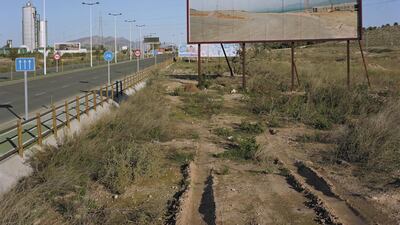When London’s Mosaic Rooms made an open call for exhibition proposals last year, it was an intriguing moment for the artistic space showcasing “the most exciting, progressive and creative voices from the Arab world”. The United Kingdom arm of the AM Qattan Foundation has had some fascinating shows from established artists in its six-year history, including the award-winning German photographer Kai Wiedenhöfer and the Egyptian painter Nermine Hammam, but this was a chance for new voices and, perhaps, fresh, untapped ideas.
The first fruits of this programme, the recently opened "lens-based media" show My Sister Who Travels, reveals just how important the scheme could be. Gathering together six contemporary female artists who look at landscape in the Mediterranean basin – the Middle East, North Africa and Europe – the clear intention is to make people look again at the countries and peoples of places such as Morocco, Lebanon, Palestine and Jordan.
“It was an exhibition that had been growing in my mind for a few years,” says its curator Martina Caruso. “The history of landscape photography tends to be more male-dominated, but I kept hearing stories from women friends of mine who are photographers and have a passion for the form. The Mediterranean served as a delimited geographical area in which we could explore questions of nationality and belonging, so what I wanted to do then was explore the way women approach landscape.”
In My Sister Who Travels, the suggestion is that they do so very differently. Corinne Silva's Imported Landscapes, for example, is a series of photographs of her journey between Tangier and Algeria. The photographs were then displayed on billboards in Spain – the images in the exhibition are of the billboards in the Spanish landscape – making a commentary on the dreams and lives of migrant workers travelling from North Africa to Europe.
In the stills from Jananne Al Ali's installation Shadow Sites II, Jordan is seen from above. It's a reference to how places in the Middle East have been viewed by many through recent wars: from the air, somewhat like a Google map.
“A lot of the artists here ask people to consider how they feel about the Mediterranean,” agrees Caruso. “I’d like it, actually, if people came away from the exhibition with more questions than answers,” Caruso said.
The Algerian artist Halida Boughriet certainly provokes plenty of discussion with Transit, a curious film focusing on a flock of swallows over Istanbul on a late February afternoon. With a soundtrack of conversations from undocumented migrants talking about their desires to leave, the subtext is clear.
“There is a strong contrast between the beauty of these birds, almost resembling fireworks, and the violence of what is being said by the migrants,” she says. “It made me think about this crossroads between East and the West. I was only the witness of this ballet taking place in front of my eyes.”
Dedicated Gulf art-watchers might remember Boughriet's film Les Illumines, a video work in which the viewer sees the world from the point of view of a burka-wearing woman in Paris, where of course the burka was banned in 2010. As she explains, it was also a kind of landscape photography. "It was like an 'integration' of a foreign body into the French urban space," she says. "And by shifting the viewpoint from the exterior to the interior, you could really feel the gazes that weigh on a woman wearing a burka."
Essentially, it confronted prejudice, which is a recurring theme both in Boughriet's work and My Sister Who Travels. "The idea of migration is important to me," she says. "I live in Paris, I am an immigrant myself ... and I hope my images can move beyond borders."
That would be the measure of success of an exhibition based in London, but with a global view of the way people experience the world.
• My Sister Who Travels is at The Mosaic Rooms, London, until August 30. For more information, visit www.mosaicrooms.org
artslife@thenational.ae

